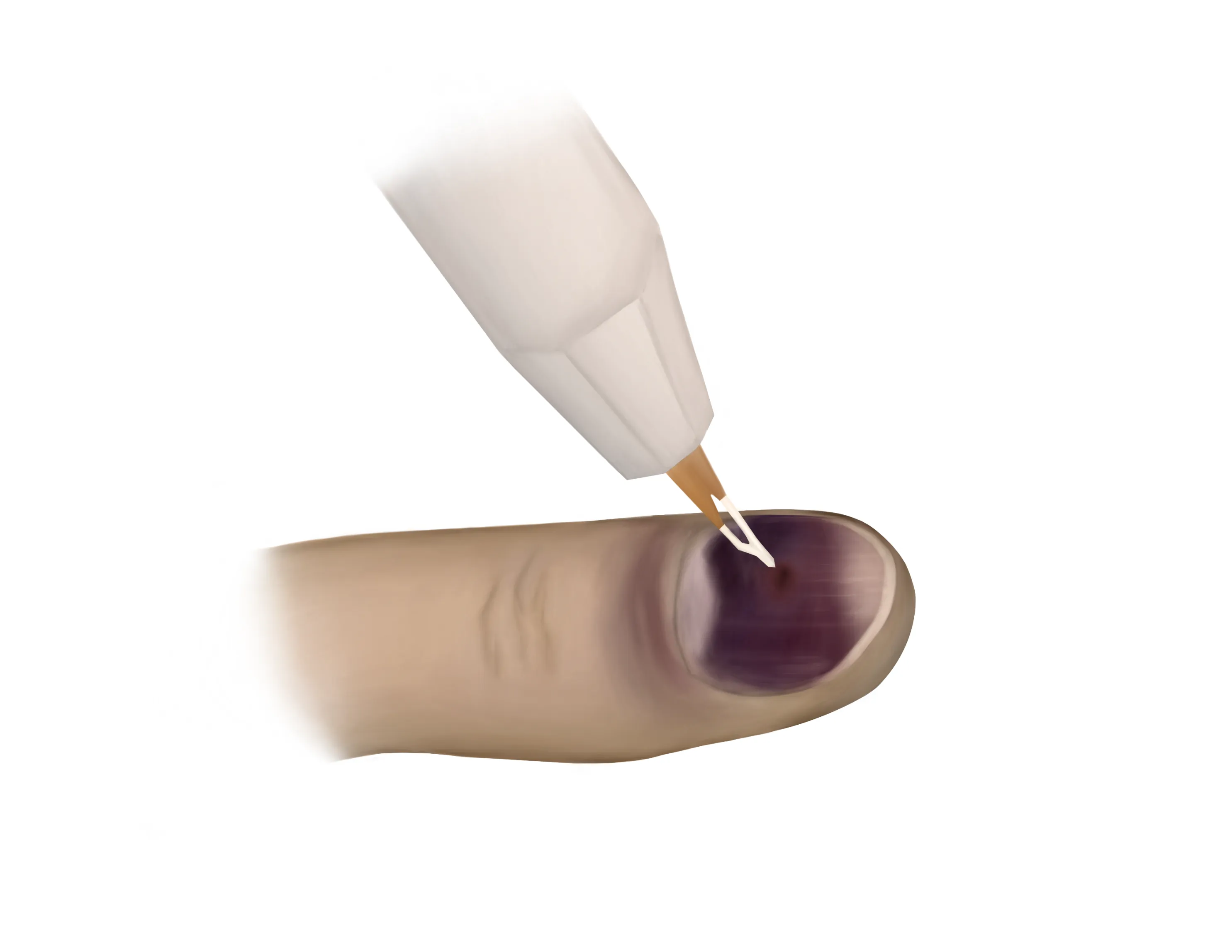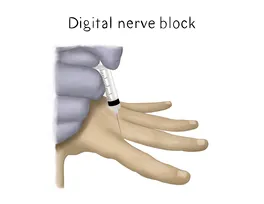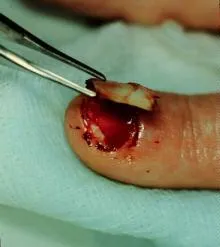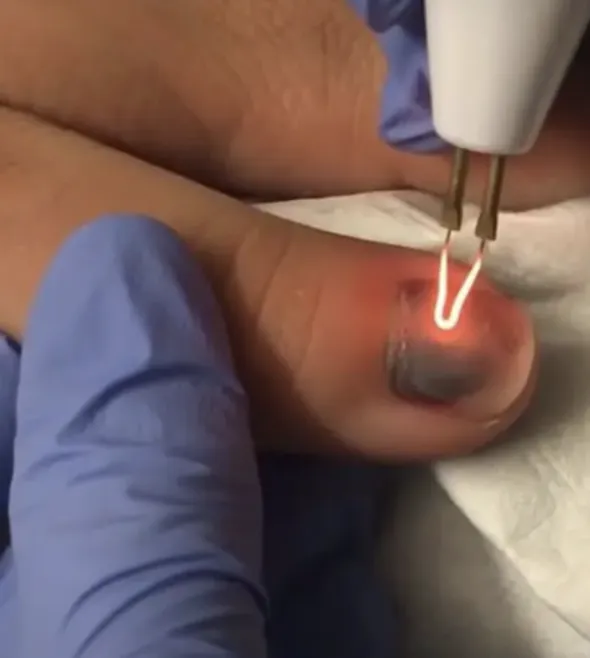Nail Bed Injury
- Commonly results from direct trauma to the fingertip (e.g. jamming a finger)
- Often will have concomitant distal phalanx fracture and/or subungual hematoma
- Most of these injuries can be managed as follows
- Damage to the nail plate +/- tuft fracture
- Nail plate removal, nail bed exploration and repair
- Discharge with orthopaedic follow up +/- oral course of 1st generation cephalosporin if there was concern for contamination
- Subungual hematoma involving > 50% of nail plate
- Nail plate removal for decompression
- Discharge with orthopaedic follow up +/- oral course of 1st generation cephalosporin
- Subungual hematoma involving < 50% of nail plate
- Trephination (either sterile 16-18G needle or portable cautery)
- Discharge with orthopaedic follow up +/- oral course of 1st generation cephalosporin
- Be wary of the distal phalanx fracture in a pediatric patient
- If the fracture is through the distal physis (see imaging below) the patient has a “Seymour fracture” and orthopaedics
- Possible operative intervention
- Mechanism
- Injuries often result from direct trauma to the fingertip
- Often have associated distal phalanx fracture and/or subungual hematoma
- Timing of injury
- Hand dominance
- Profession
- Other injuries
Vitals
- Distal sensation on ulnar and radial side of the injured finger
- Two point discrimination
- Capillary refill
- Extension of distal interphalangeal joint (DIPJ)
- Depending on the extent of the injury, there may be a concomitant extensor tendon injury
- Flexion of the DIPJ
- AP/Lateral/Oblique of involved finger
- Useful to rule out a fracture of the distal phalanx
- Critical to rule out "Seymour fracture" in pediatric patients
Medical Decision Making
Nail Bed Removal
*** is a *** y/o ***-hand dominant individual with hx of *** who presents with nail bed injury to the R/L index/middle/long/ring/thumb***. On exam, the patient is neurovascularly intact with normal flexion & extension of the DIP joint and appropriate two point discrimation distally. Radiographs reveal ***. The nail was removed and the nail bed was thoroughly irrigated and repaired with eponychial coverage using the nail plate/foil***. The patient was placed on oral ***antibiotic and will follow up in clinic in 7-10 days for repeat evaluation.
Nail Trephination (subungual hematoma < 50% of nail plate)
*** is a *** y/o ***-hand dominant individual with hx of *** who presents with nail bed injury to the R/L index/middle/long/ring/thumb***. On exam, the patient is neurovascularly intact with normal flexion & extension of the DIPJ and appropriate two point discrimation distally. There was noted to be a subungual hematoma < 50% of the nail plate so the decision was made to trephinate and decompress. Radiographs reveal ***. The patient was placed on oral ***antibiotic and will follow up in clinic in 7-10 days for repeat evaluation.
Seymour Fracture (fracture through physis of the distal phalanx in a pediatric pt):
- Consult hand surgery (orthopaedics vs. plastic surgery)
- Diet: NPO
- Disposition: Possible admission for Irrigation and Debridement
- WB status: Nonweightbearing injured finger
- Diet: Regular
- Analgesia: short course of narcotic pain medication, tylenol (scheduled)
- Ex: 5mg oxycodone q4 - 15 pills
- Procedure: Nail plate removal, nail bed exploration, repair
- See procedure technique below
- Antibiotics: Variable depending on the degree of contamination
- Providers often prescribe cephalexin 500mg q12 for 7 days
- Disposition: Home with follow up in hand surgery clinic in 1 week
- WB status: Nonweightbearing injured finger
- Diet: Regular
- Analgesia: short course of narcotic pain medication, tylenol (scheduled)
- Ex: 5mg oxycodone q4 - 15 pills
- Procedure
- < 50 % of nail - trephination (decompress hematoma)
- See procedure technique below
- > 50% the nail plate - remove nail plate for decompression
- See procedure technique below
- Antibiotics: Variable depending on the degree of contamination
- Providers often prescribe cephalexin 500mg q12 for 7 days
- Disposition: Follow up with orthopaedic surgery within 2 weeks
Materials
Procedure Walkthroughs:
- Perform digital block
- Use chlorhexidine to wipe off skin sites for block
- 4-6cc of 1% lidocaine
- Prep the hand using betadine or another antimicrobial agent
- Irrigate wound with 500 mL normal saline mixed with dilute betadine
- Removing the nail
- Use scissors or freer elevator (if available) to spread underneath the eponychium and free the nail as you work distal to proximal
- Gentle traction with a hemostat on the nail to avoid damaging the germinal matrix
- If intact, soak the nail in betadine while you finish the procedure
- Repair lacerations (if applicable)
- Irrigate wound with additional 1.5L sterile saline mixed with dilute betadine
- 5-0 or 6-0 chromic absorbable suture to approximate wound edges
- Return native nail to nail bed under the eponychium if possible
- if unable to use nail, use foil from suture packaging or xeroform as a biologic dressing
- Dermabond vs. 4-0 chromic absorbable suture to secure native nail to nail bed
- Equivalent outcomes between dermabond and chromic in the literature
- Dress the finger using xeroform and kling (small rolled gauze)
Procedure Notes:
PROCEDURE NOTE - Repair of nail bed
PRE-PROCEDURE DIAGNOSIS: Nail bed injury on the *** upper/lower extremity
POST-PROCEDURE DIAGNOSIS: Same (refer above)
PROCEDURALIST: ***
ANESTHESIA: Digital nerve block (see separate procedure note)
NAME OF PROCEDURE: Repair of nail bed
PROCEDURE IN DETAIL:
The risks and benefits of irrigation and debridement of the injury and nail bed removal and repair were discussed at length with the patient. Risks discussed included but were not limited to infection, potential for germinal matrix damage and poor cosmesis, need for repeat procedure, possible germinal matrix arrest, numbness and persistent finger pain. Following informed verbal consent with discussion of risks and benefits, the patient agreed to proceed with the procedure. A timeout was performed.
The affected finger was prepped with betadine and draped in a sterile manner. Next, a digital block with ***mL of 1% lidocaine (without epinephrine) was performed in standard fashion with care taken to block the radial and ulnar neurovascular bundle. The wound was irrigated with 500mL normal saline. The nail was elevated from the nail bed using a ***freer elevator/hemostat with care taken at the level of the germinal matrix. The nail was scrubbed of debris using betadine solution. ***The portion of the laceration extending beyond the nail bed was repaired with chromic gut sutures. The removed nail was inserted into the nail fold as a biologic dressing and held in place with adhesive skin glue. Bacitracin ointment was applied to laceration. A soft dressing was applied. The patient tolerated the procedure well. Neurovascular status was reassessed after the procedure and found to be consistent with baseline.
ESTIMATED BLOOD LOSS: Minimal
COMPLICATIONS: None
DISPOSITION:
Home with PO ***Keflex for 7 days. Remain in soft dressing until follow-up visit in 7-10 days.
PRE-PROCEDURE DIAGNOSIS: Nail bed injury on the *** upper/lower extremity
POST-PROCEDURE DIAGNOSIS: Same (refer above)
PROCEDURALIST: ***
ANESTHESIA: Digital nerve block (see separate procedure note)
NAME OF PROCEDURE: Repair of nail bed
PROCEDURE IN DETAIL:
The risks and benefits of irrigation and debridement of the injury and nail bed removal and repair were discussed at length with the patient. Risks discussed included but were not limited to infection, potential for germinal matrix damage and poor cosmesis, need for repeat procedure, possible germinal matrix arrest, numbness and persistent finger pain. Following informed verbal consent with discussion of risks and benefits, the patient agreed to proceed with the procedure. A timeout was performed.
The affected finger was prepped with betadine and draped in a sterile manner. Next, a digital block with ***mL of 1% lidocaine (without epinephrine) was performed in standard fashion with care taken to block the radial and ulnar neurovascular bundle. The wound was irrigated with 500mL normal saline. The nail was elevated from the nail bed using a ***freer elevator/hemostat with care taken at the level of the germinal matrix. The nail was scrubbed of debris using betadine solution. ***The portion of the laceration extending beyond the nail bed was repaired with chromic gut sutures. The removed nail was inserted into the nail fold as a biologic dressing and held in place with adhesive skin glue. Bacitracin ointment was applied to laceration. A soft dressing was applied. The patient tolerated the procedure well. Neurovascular status was reassessed after the procedure and found to be consistent with baseline.
ESTIMATED BLOOD LOSS: Minimal
COMPLICATIONS: None
DISPOSITION:
Home with PO ***Keflex for 7 days. Remain in soft dressing until follow-up visit in 7-10 days.
PROCEDURE NOTE Evacuation of subungual hematoma
PRE-PROCEDURE DIAGNOSIS: Subungual hematoma
POST-PROCEDURE DIAGNOSIS: Same (refer above)
PROCEDURALIST: ***
ANESTHESIA: None
NAME OF PROCEDURE: Evacuation of subungual hematoma
PROCEDURE IN DETAIL:
The risks and benefits of nail plate trephination were discussed at length with the patient. Risks discussed included but were not limited to infection, nail bed injury, potential for germinal matrix damage and poor cosmesis, need for repeat procedure, possible germinal matrix arrest, numbness and persistent finger pain. Following informed verbal consent with discussion of risks and benefits, the patient agreed to proceed with procedure. A timeout was performed.
The affected finger was prepped with soap and water. Using a ***sterile 16-18 gauge needle/portable cautery the subungual hematoma was trephinated and decompressed. The nail was irrigated with 500mL normal saline. A soft dressing of xeroform and kling was applied. The patient tolerated the procedure well. Neurovascular status was reassessed after the procedure and found to be consistent with baseline.
ESTIMATED BLOOD LOSS:: Minimal
COMPLICATIONS: None
DISPOSITION:
Discharge home with orthopaedic follow up within 2 weeks
PRE-PROCEDURE DIAGNOSIS: Subungual hematoma
POST-PROCEDURE DIAGNOSIS: Same (refer above)
PROCEDURALIST: ***
ANESTHESIA: None
NAME OF PROCEDURE: Evacuation of subungual hematoma
PROCEDURE IN DETAIL:
The risks and benefits of nail plate trephination were discussed at length with the patient. Risks discussed included but were not limited to infection, nail bed injury, potential for germinal matrix damage and poor cosmesis, need for repeat procedure, possible germinal matrix arrest, numbness and persistent finger pain. Following informed verbal consent with discussion of risks and benefits, the patient agreed to proceed with procedure. A timeout was performed.
The affected finger was prepped with soap and water. Using a ***sterile 16-18 gauge needle/portable cautery the subungual hematoma was trephinated and decompressed. The nail was irrigated with 500mL normal saline. A soft dressing of xeroform and kling was applied. The patient tolerated the procedure well. Neurovascular status was reassessed after the procedure and found to be consistent with baseline.
ESTIMATED BLOOD LOSS:: Minimal
COMPLICATIONS: None
DISPOSITION:
Discharge home with orthopaedic follow up within 2 weeks
| Common ICD-10 Codes | Brief Description |
|---|---|
| S60.1 | Contusion of finger with damage to nail |
| S61.1 | Open wound of thumb with damage to nail |
| S61.15 | Open bite of thumb with damage to nail |
| S61.3 | Open wound of other finger with damage to nail |
| L60.8 | Other nail disorders |
| L60.9 | Nail disorder, unspecified |
- Holtzman L. Incision and Drainage. In: Roberts and Hedges' Clinical Procedures in Emergency Medicine. 6th ed. Philadelphia, PA: Elsevier; 2014.
- Seaberg DC, ANgelos WJ, et al. Treatment of subungual hematomas with nail trephination: a prospective study. Am J Emerg Med. 1991; 9(3):209-210
- Tintinalli, J. E., Stapczynski, J. S., Ma, O. J., Yealy, D. M., Meckler, G. D., & Cline, D. (2016). Injuries to Bones and Joints In Tintinalli's emergency medicine: A comprehensive study guide (Eighth edition.) (pp1863-1864). New York: McGraw-Hill Education.
- Davenport M. Procedures for orthopedic emergencies. In: Bond M, ed. Orthopedic Emergencies: Expert Management for the Emergency Physician. Cambridge: Cambridge University Press; October 31, 2013.
- Roser SE, Gellman H. Comparison of nail bed repair versus nail trephination for subungual hematomas in children. J Hand Surg. 1999;24(6):2266-1170.
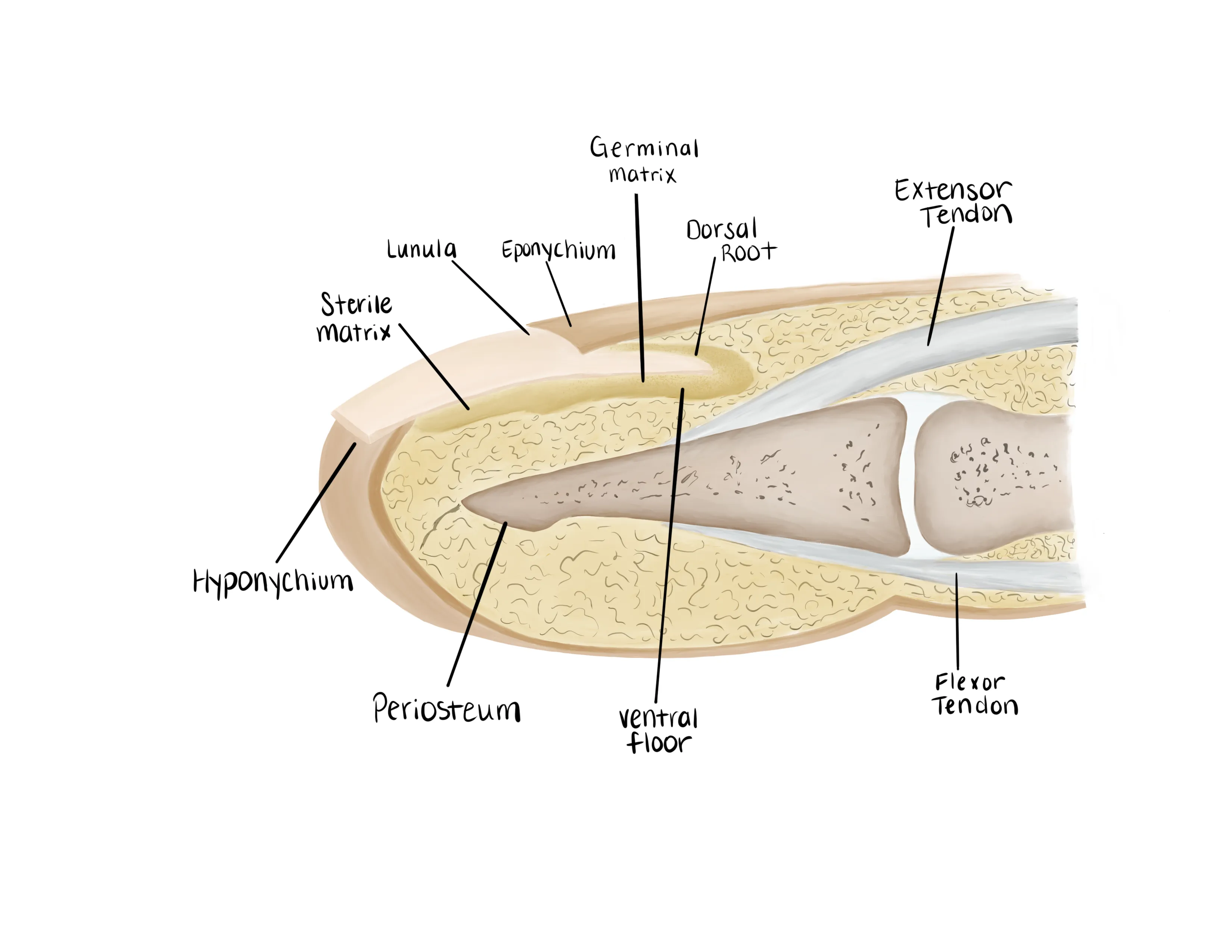

.webp)
